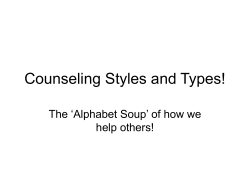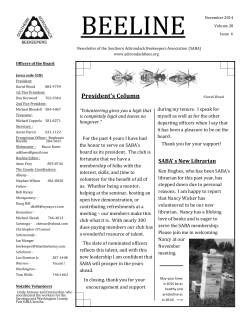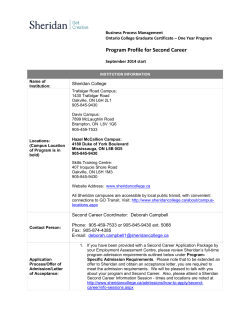
Filling the Void: Real-time Interaction in the Online Learning and Support Environment
Filling the Void: Real-time Interaction in the Online Learning and Support Environment Presenters Beau Corkins, Math Faculty Gillette College bcorkins@sheridan.edu Keri DeDeo, English Faculty Sheridan College kdedeo@sheridan.edu Stoney Gaddy, Director of Distance & Distributive Learning sgaddy@sheridan.edu Reaching Students at a Distance Why is it important? _________________________________ _________________________________ _________________________________ _________________________________ _________________________________ _________________________________ Web Conferencing in Academia Virtual office hours Scheduled lectures/presentations/discussions Fully online synchronous courses Technical support Academic support Student support Other uses? Web Conferencing Platforms Solution Address Adobe Connect http://www.adobe.com/products/adobeconnect.html Blackboard Collaborate http://www.blackboard.com/Platforms/Collaborate/overview.aspx Cisco WebEx http://www.webex.com GoToMeeting http://www.gotomeeting.com Saba Centra http://www.saba.com/online-collaboration-tools Google+ Hangouts http://www.google.com/+/learnmore/ Transactional Distance Theory More than just a physical separation, the variable "transactional distance" is defined as "a psychological and communications space to be crossed, a space of potential misunderstanding between the inputs of instructor and those of the learner". Michael Moore. Theory of Transactional Distance. 1993. In D. Keegan (Ed.), Theoretical principles of distance education . Page 23. London: Routledge Transactional Distance Theory Key interactive components that have to work together to shorten the transactional distance and provide for a meaningful learning experience: Dialog between students and faculty where both parties contribute Structure of the course to include text, media, and communication tools Autonomy of the student to be responsible for their own learning processes Farhad Saba’s systems dynamics hypotheses In 1988, Farhad Saba proposed a system dynamics model to represent the relationship among dialog and structure. • When structure increases, transactional distance increases and dialog decreases. • When dialog increases, transactional distance decreases and structure decreases. The success of online distance education may well depend upon the ability of educational leaders to personalize the teaching and learning process to satisfy and retain distance students (Saba, 1999). Saba, F. (1999). Architecture of dynamic distance instructional and learning systems. Distance Education Report, 3(8), 1-5. Narrowing the Gap If a large transactional distance exists between geographically dispersed learners and instructors, can Web conferencing be used to: reduce feelings of disconnectedness increase engagement (dialog) reduce confusion increase learning reduce attrition increase motivation reduce travel time and expense increase satisfaction (students AND faculty) http://wyoroad.info A Brief NWCCD Timeline (from pilot to Bb Building block) – Implementation to Usage Summer 2010 – Purchased ElluminateLive! Fall 2010 - Blackboard 9.1 implemented (20% of online courses, 52 courses) Fall 2010 - ElluminateLive! building block implemented in Blackboard 9.1 Only a handful of instructors used it October 2010 - DEC began using Elluminate exclusively Spring 2011 – ElluminateLive! menu item added to each course shell Team sites begin to sprout up Sp11-Sp12 Nursing, Dental Hygiene, ITS, Library, GC Writing Center Spring 2012 - New sessions now in Collaborate 11 Summer 2012 - Complete migration to Collaborate 11 Virtual Classroom – Keri DeDeo When you can’t get to class. Present a lesson from home Students in the classroom Virtual Office Hours Co-presentation for online & traditional classroom. Synchronous sessions Caveats & Solutions Feedback Virtual Office (One-on-One Help) – Keri Schedule Materials Instructions (video & print) Emergency number Expectations Schedule individual sessions Virtual Office (One-on-One Help) – Keri Discussed essay via phone while looking at the same document. Student expectations unclear. Co-Presentation – Keri Co-presentation for online & traditional classroom Synchronous Session – Keri • • • • • • • • Pick Topic. Schedule poll for session. Remind students often. Practice with the technology so it runs smoothly. Record session for later use. Give students completion survey. Make improvements as needed for future session. Link students to recorded session Caveats & Solutions - Keri Technology issues in the classroom Get in early Have a practice run Have IT standing by Online students relying on recording & not attending Let them know if no one is there, a recording will not be made. Students do not have proper technology Set up expectations beforehand: speakers, broadband, any handouts, texts. Optional equipment: webcam, microphone (can use phone). Do what you can so students do not incur charges via phone or internet. Student Feedback– Keri A few of my favorites: “This was very helpful.” “Wow! This is awesome!” “Oh. I wish I knew about this earlier in my college career.” “Sometimes, your voice cuts out. I think it’s my Internet.” “Can we do this every week?” “This was fun, but we miss you!” Virtual Classroom - Beau Corkins Virtual Classroom - Beau Student Perspective Very helpful Work can be clearly seen and then copied down in Collaborate Responses in emails are sometimes hard to follow It is nice being able to get questions answered in real time versus waiting for email response Instructor Perspective Drawing Math symbols are much easier than typing a half hour email Showing work/method is usually much simpler to demonstrate Application sharing to show my desktop or see their desktop Technical Support Distance Learning Help Desk Support Other possibilities? Academic Support Tutoring We are currently using Smarthinking extensively Some discussion on using student tutors in Collaborate to supplement Smarthinking and reduce costs Writing Center We are currently using Smarthinking extensively Some discussion on using student tutors in Collaborate to supplement Smarthinking and reduce costs Library Implemented an “Ask a Librarian” chat solution staffed by full-time, part-time, and student employees Co-presentation for online & traditional classroom. Student Support Counseling Deanne Wyssmann, Director of Counseling Services, has expressed interested and participated in ElluminateLive! Training. While online students who are distanced from campus have a social and support network, we need to provide these services to our online students. Advising This is not yet on our radar screen Admissions, Registration, Financial Aid Our proposed Student-operated Online Concierge Service will be able to address some admissions, enrollment, and financial aid questions Committee Meetings Two colleges separated by 99 miles A fair number of staff and faculty members drive this on a frequent basis Weather is a factor in the winter ITV video conference rooms and classrooms in 16 locations Committee work with document distribution and on-the-fly editing difficult Distance Education Committee began meeting exclusively in ElluminateLive! starting October 2010. Fully Online (Synchronous) Courses www.wyclass.wy.edu What do we have in store for the future Student-operated concierge service – evenings and weekends 100% Web conference courses Workforce Development Training Initiatives What Web conferencing initiatives has your institution pursued? Questions, Comments, Concerns
© Copyright 2025





















